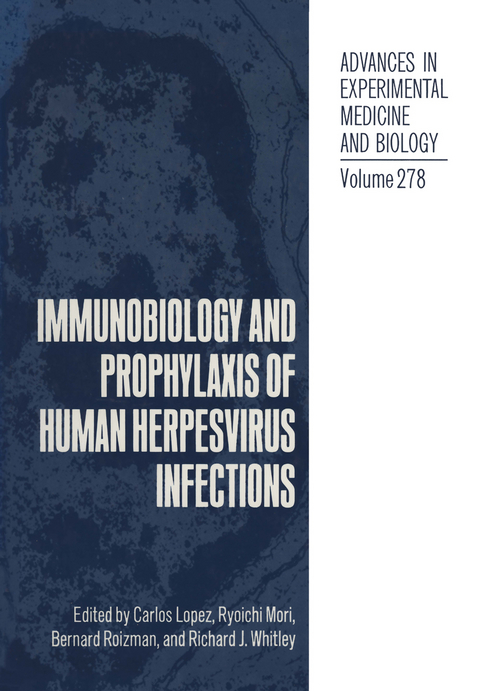
Immunobiology and Prophylaxis of Human Herpesvirus Infections
Springer-Verlag New York Inc.
978-1-4684-5855-8 (ISBN)
Human Herpesvirus No. 6.- Cellular and Growth-Factor Requirements for the Replication of Human Herpesvirus 6 in Primary Lymphocyte Cultures.- Genomic Heterogeneity of Human Herpesvirus 6 Isolates.- Replication of Human Herpesvirus 6 (HHV-6): Morphological Aspects.- Exanthem Subitum and Human Herpesvirus 6 (HHV-6) Infection.- Viral Pathology of Human Herpesvirus 6 Infection.- Immunobiology of Varicella-Zoster Virus.- A Live Varicella Vaccine.- Differentiation between the Oka Varicella Vaccine Virus and American Wild-Type Varicella-Zoster Virus (VZV).- The T-Lymphocyte Response to Varicella-Zoster Viral Proteins.- A Possible Role for Glycoprotein gpV in the Pathogenesis of Varicella-Zoster Virus.- Human Cytomegalovirus.- Changes in the Epidemiology of Cytomegalovirus.- Antiviral Activities of a Human Monoclonal Antibody against Human Cytomegalovirus.- Epstein-Barr Virus.- Topological Effects of EBNA 1 on oriP.- Detection of 12-o-Tetradecanoylphorbol-13-Acetate-induced Cellular Proteins That Compete with the Epstein-Barr Virus Nuclear Antigen 1 (EBNA-1) for Binding to a Site within the Epstein-Barr Virus oriP.- On the Biology of Epstein-Barr Virus Persistence: A Reappraisal.- Epstein-Barr Virus, Burkitt’s Lymphoma, and an African Tumor Promoter.- Herpes Simplex Virus.- Regulation of Expression of the Glycoprotein Genes of Herpes Simplex Virus Type 1 (HSV-1).- Antigenic and Structural Properties of Mutants in Herpes Simplex Virus 1 Glycoprotein B.- Yeast-derived Glycoprotein B-1 of Herpes Simplex Virus (HSV) as a Candidate for an HSV Vaccine.- Herpes Simplex Virus Type 1 Infection in Mice with Severe Combined Immunodeficiency (SCID).- Herpes Simplex Virus Latency.- Transcripts Associated with Herpes Simplex Virus Latency.- Pathogenesis and Latency of Herpes Simplex VirusType 1 (HSV-1): An Ophthalmologist’s View of the Eye as a Model for the Study of the Virus-Host Relationship.- Mechanisms of Restriction of Viral Gene Expression during Herpes Simplex Virus Latency.- Diagnostics.- Detection of a Highly Conserved Region of Herpesviridae DNA by In Vitro Enzymatic Amplification: Application to the Detection of a New Human Herpesvirus.- Prevalence of Specific Antibodies to Herpes Simplex Virus Type 2 as Revealed by an Enzyme-linked Immunoassay and Western Blot Analysis.- Chemotherapy of Herpesvirus Infections.- Acyclovir: The Past Ten Years.- Brovavir: Its Antiherpesviral Activity and Mode of Action.- A Double-Blind Clinical Study in Patients with Herpes Zoster to Establish YN-72 (Brovavir) Dose.- (S)-1-(3-Hydroxy-2-(phosphonylmethoxy)propyl)cytosine (HPMPC): A Potent Antiherpesvirus Agent.- Conclusions.- Whither Herpesviruses?.- Author Index.
| Reihe/Serie | Advances in Experimental Medicine and Biology ; 278 |
|---|---|
| Zusatzinfo | 306 p. |
| Verlagsort | New York, NY |
| Sprache | englisch |
| Maße | 170 x 244 mm |
| Themenwelt | Sachbuch/Ratgeber ► Natur / Technik ► Garten |
| Medizin / Pharmazie ► Medizinische Fachgebiete ► Mikrobiologie / Infektologie / Reisemedizin | |
| Studium ► Querschnittsbereiche ► Infektiologie / Immunologie | |
| Naturwissenschaften ► Biologie ► Botanik | |
| Naturwissenschaften ► Biologie ► Mikrobiologie / Immunologie | |
| Naturwissenschaften ► Biologie ► Ökologie / Naturschutz | |
| Naturwissenschaften ► Biologie ► Zoologie | |
| ISBN-10 | 1-4684-5855-8 / 1468458558 |
| ISBN-13 | 978-1-4684-5855-8 / 9781468458558 |
| Zustand | Neuware |
| Haben Sie eine Frage zum Produkt? |
aus dem Bereich


